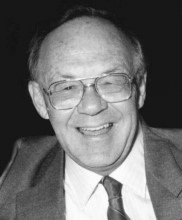William M. Sinton
William M. Sinton

William M. Sinton was born in Baltimore on April 11, 1925. He developed lifelong interests in railroads and radios while still a child, and by age 15 he had already built a shortwave radio receiver and won his ham radio license. He obtained his bachelor’s degree in physics at Johns Hopkins 1949. He obtained his Ph.D. also from Hopkins, on the infrared spectrum and temperature of Venus, in 1953. During a 1-year postdoc at Hopkins, he probed the lunar subsurface by observing the cooling of the moon during eclipse at millimeter wavelengths and observed the diurnal variation in Martian surface temperatures in the 10- micron window.
He joined Harvard College Observatory as a research associate and lecturer in 1954. In 1956, using a monochromator that he built himself, he detected absorptions near 3.4 microns in the Martian spectrum which he attributed to a C-H stretch transition in Martian vegetation. These ‘‘Sinton bands,’’ as they came to be known, sparked great interest at the time, and though at least some of the spectral structure was later found to be due to terrestrial HDO, and the presence of abundant organic molecules on the Martian surface was finally ruled out by the Viking landers, some of the spectral features that he detected appear to be intrinsic to Mars and are still not well understood.
In 1957, he moved to Lowell Observatory, and spent the next nine years there. In his time at Lowell, he continued his studies of the Moon’s thermal emission, and built an infrared Michelson interferometer spectrometer that he put to use in identifying the 3.1-micron water of hydration band on Mars. He also met and married his wife Marge in 1960, and their three sons, Bob, David, and Alan were born. In 1965, Bill was invited by John Jefferies to join the faculty of the University of Hawaii, and to help in the development of the fledgling Mauna Kea Observatory. His work on the design the 88-inch telescope on Mauna Kea, the cornerstone of the observatory, included designing its telescope control system, making it one of the first computer-controlled optical telescopes. His scientific work at the Institute for Astronomy included continued studies of Mars as well as the infrared spectrum of Uranus and Neptune. He sometimes translated his pseudocolored maps of the thermal emission from the planets, pixel by pixel, into stained glass.
In 1979, following the discovery of Io’s volcanoes by Voyager, he obtained some of the first ground-based observations of the infrared thermal emission from the volcanoes. He devoted the last decade of his career to the ground-based study of Io’s volcanoes, working to characterize their time variability and developing techniques to identify their locations on Io. He was one of the founding members of the International Jupiter Watch in 1987 and was the first leader of its Satellite Discipline. When he retired from the University of Hawaii in 1990, he and Marge returned to Flagstaff, and he renewed his association with Lowell Observatory as an adjunct astronomer.
In 2002 he published an autobiography, I Choose to Live. Throughout his career, he received many awards and recognitions, including the 1954 Adolph Lomb Medal from OSA. He was also elected an OSA Fellow in 1961.
Sinton passed away in 2004.
Document Created: 26 July 2023
Last Updated: 28 August 2023
